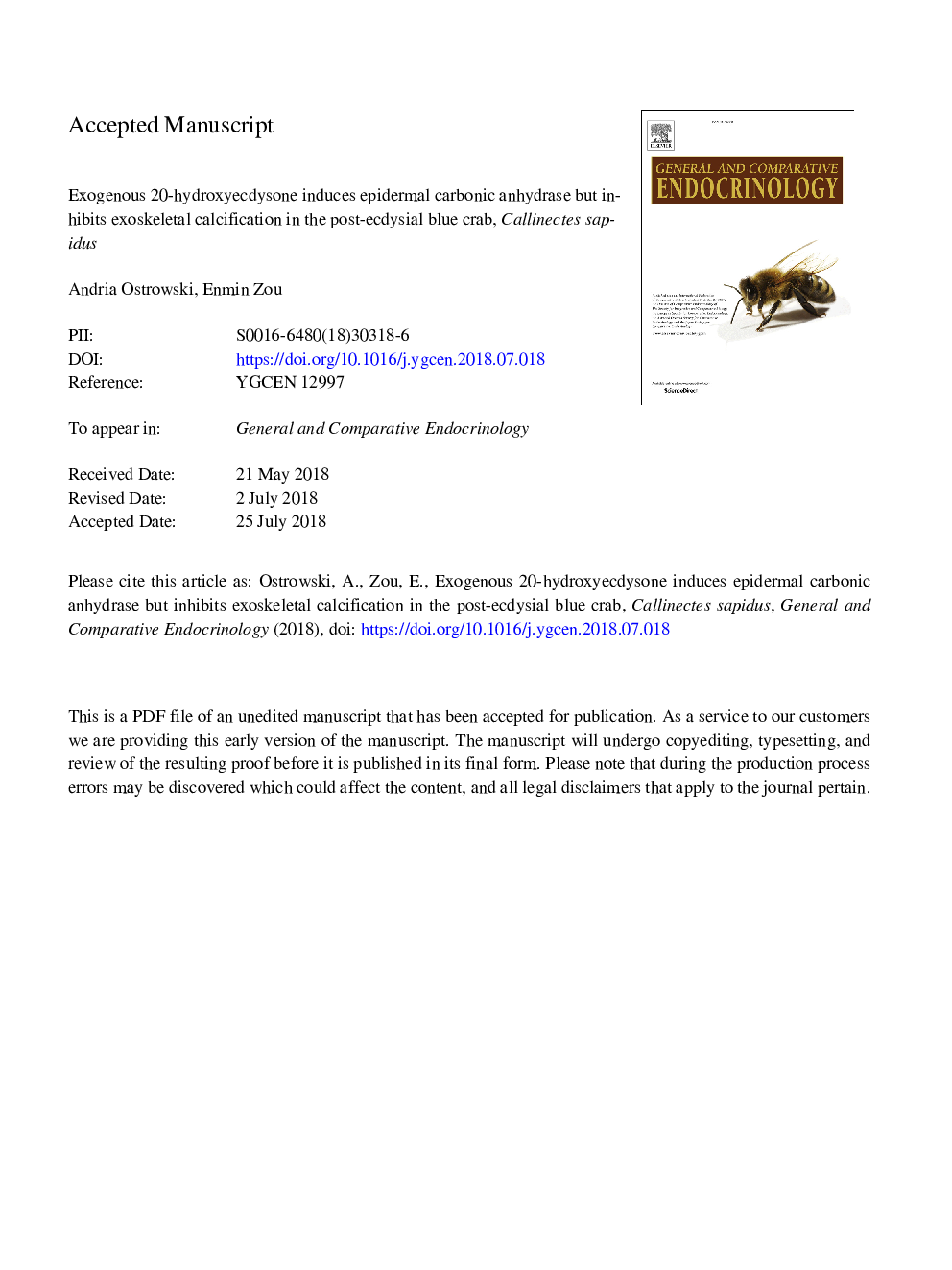| کد مقاله | کد نشریه | سال انتشار | مقاله انگلیسی | نسخه تمام متن |
|---|---|---|---|---|
| 11022669 | 1701473 | 2018 | 28 صفحه PDF | دانلود رایگان |
عنوان انگلیسی مقاله ISI
Exogenous 20-hydroxyecdysone induces epidermal carbonic anhydrase but inhibits exoskeletal calcification in the post-ecdysial blue crab, Callinectes sapidus
دانلود مقاله + سفارش ترجمه
دانلود مقاله ISI انگلیسی
رایگان برای ایرانیان
کلمات کلیدی
موضوعات مرتبط
علوم زیستی و بیوفناوری
بیوشیمی، ژنتیک و زیست شناسی مولکولی
علوم غدد
پیش نمایش صفحه اول مقاله

چکیده انگلیسی
The crustacean exoskeleton is composed primarily of chitin, proteins and various inorganic compounds. It is the inorganic compounds, such as calcium and magnesium, that underlie the exoskeletal mineralization process following ecdysis. Little is known about the hormonal mechanism for this process in crustaceans. Carbonic anhydrase (CA) in the epidermis has been suggested to aid in deposition of calcium and magnesium carbonates to the exoskeleton in crustaceans by generating bicarbonate ions, resulting in mineralization. Given a similar pattern of fluctuation in prevalence between epidermal CA and ecdysteroids during the crab molting cycle, it has been proposed in a previous study that post-ecdysial epidermal CA and subsequent metal deposition to the exoskeleton are controlled by the ecdysteroid molting hormones in the blue crab, Callinectes sapidus. This study sought to acquire evidence to support such a proposition. Early postmolt and early intermolt blue crabs were used to quantify epidermal CA mRNA expression when exposed in vitro to three physiologically relevant concentrations of 10â¯nM, 100â¯nM and 1â¯Î¼M 20-hydroxyecdysone (20-HE), using the epidermis-with-exoskeleton (EWE) tissue assay method. It was found that 100â¯nM 20-HE significantly induced the mRNA of CasCAg, a CA isoenzyme, in epidermal tissues of early intermolt crabs and that injection of 20-HE at a dose of 15â¯ng/g significantly elevated epidermal CA activity in vivo in early intermolt crabs. These two lines of evidence clearly show that post-ecdysial epidermal CA is influenced by the molting hormone. Interestingly, exoskeletal calcium content was significantly lower in the 20-HE treated crabs than in the control, whereas magnesium content was unchanged. The inhibition of calcification in the post-ecdysial exoskeleton by the exogenous molting hormone may implicate that sclerotization and mineralization of the new shell must be coordinated and that enhanced deposition of carbonate salts as a result of increased epidermal CA activity following the administration of exogenous molting hormone would be inhibited to avoid the formation of a structurally disrupted exoskeleton.
ناشر
Database: Elsevier - ScienceDirect (ساینس دایرکت)
Journal: General and Comparative Endocrinology - Volume 268, 1 November 2018, Pages 57-63
Journal: General and Comparative Endocrinology - Volume 268, 1 November 2018, Pages 57-63
نویسندگان
Andria Ostrowski, Enmin Zou,